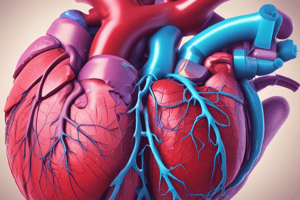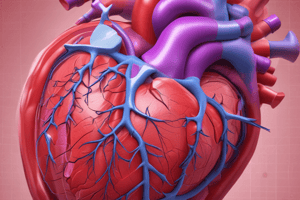Podcast
Questions and Answers
What is the primary consequence of a ventricular septal defect (VSD)?
What is the primary consequence of a ventricular septal defect (VSD)?
- Increased pulmonary blood flow (correct)
- Decreased systemic blood flow
- Decreased left atrial pressure
- Increased ventricular compliance
Which diagnostic technique is considered the primary tool for assessing a ventricular septal defect?
Which diagnostic technique is considered the primary tool for assessing a ventricular septal defect?
- Electrocardiogram (ECG)
- Echocardiogram (correct)
- Chest X-ray
- Cardiac Catheterization
What is a surgical indication for a ventricular septal defect?
What is a surgical indication for a ventricular septal defect?
- Once the defect closes spontaneously
- Defect size is less than 1 mm
- Presence of pulmonary hypertension (correct)
- Patient is asymptomatic with a small VSD
Which of the following is a common symptom of moderate to large ventricular septal defects?
Which of the following is a common symptom of moderate to large ventricular septal defects?
What might an electrocardiogram (ECG) reveal in a patient with a ventricular septal defect?
What might an electrocardiogram (ECG) reveal in a patient with a ventricular septal defect?
What is the long-term management strategy for patients with a ventricular septal defect?
What is the long-term management strategy for patients with a ventricular septal defect?
Which treatment is appropriate for managing symptoms in patients with heart failure due to a ventricular septal defect?
Which treatment is appropriate for managing symptoms in patients with heart failure due to a ventricular septal defect?
Which of the following symptoms might suggest heart failure in a patient with a ventricular septal defect?
Which of the following symptoms might suggest heart failure in a patient with a ventricular septal defect?
What is the primary mechanism by which an open ductus arteriosus causes increased pulmonary blood flow?
What is the primary mechanism by which an open ductus arteriosus causes increased pulmonary blood flow?
Which clinical manifestation is more likely to occur in a patient with a larger patent ductus arteriosus?
Which clinical manifestation is more likely to occur in a patient with a larger patent ductus arteriosus?
Which diagnostic technique can provide detailed anatomical evaluation of the ductus arteriosus?
Which diagnostic technique can provide detailed anatomical evaluation of the ductus arteriosus?
What treatment option is recommended for a symptomatic patent ductus arteriosus in infants?
What treatment option is recommended for a symptomatic patent ductus arteriosus in infants?
What potential complication can arise from untreated patent ductus arteriosus in the long term?
What potential complication can arise from untreated patent ductus arteriosus in the long term?
In which scenario would observation be the preferred management strategy for a patent ductus arteriosus?
In which scenario would observation be the preferred management strategy for a patent ductus arteriosus?
Which finding on a chest X-ray may indicate the presence of a patent ductus arteriosus?
Which finding on a chest X-ray may indicate the presence of a patent ductus arteriosus?
What is the main purpose of using NSAIDs like indomethacin in the treatment of patent ductus arteriosus?
What is the main purpose of using NSAIDs like indomethacin in the treatment of patent ductus arteriosus?
Study Notes
Pathophysiology
- A ventricular septal defect (VSD) is a congenital heart defect characterized by an opening in the ventricular septum.
- Causes left-to-right shunting of blood, leading to increased pulmonary blood flow.
- Can result in volume overload of the left atrium and ventricle.
- May lead to pulmonary hypertension, heart failure, or Eisenmenger syndrome if untreated.
Diagnostic Techniques
- Echocardiogram: Primary tool for visualizing the defect, assessing size and hemodynamic significance.
- Chest X-ray: Can show cardiomegaly and increased pulmonary vascular markings.
- Electrocardiogram (ECG): May indicate left ventricular hypertrophy or other abnormalities.
- Cardiac MRI: Useful for detailed anatomical assessment and measuring shunt size.
- Cardiac Catheterization: Invasive procedure to measure pressures and assess the degree of shunting.
Treatment Options
- Observation: Small, asymptomatic VSDs may close spontaneously.
- Medications: Diuretics, ACE inhibitors, or beta-blockers to manage symptoms in heart failure.
- Surgical Repair: Recommended for large defects, symptomatic patients, or those with pulmonary hypertension.
- Catheter-based closure: Minimally invasive option for suitable defects.
Long-term Management
- Regular follow-up with a cardiologist for monitoring.
- Echocardiograms may be needed periodically to assess for potential complications or changes in defect size.
- Patients should be educated on signs of heart failure or pulmonary complications.
- Consideration for endocarditis prophylaxis in certain cases.
Clinical Symptoms
- Small VSDs: Often asymptomatic.
- Moderate to large VSDs: Symptoms may include:
- Heart murmur (holosystolic)
- Fatigue and poor growth in infants
- Shortness of breath, particularly during exertion
- Frequent respiratory infections
- Signs of heart failure (e.g., edema, tachycardia) in severe cases.
Pathophysiology
- Ventricular septal defect (VSD) is a congenital heart defect with an opening in the ventricular septum.
- Results in left-to-right shunting of blood, causing excessive blood flow to the lungs.
- Increased pulmonary blood flow can overload the left atrium and ventricle, leading to complications.
- Untreated VSD may progress to pulmonary hypertension, heart failure, or Eisenmenger syndrome.
Diagnostic Techniques
- Echocardiogram: Main diagnostic tool, provides visualization of the defect, its size, and hemodynamic impact.
- Chest X-ray: May reveal cardiomegaly and heightened pulmonary vascular markings.
- Electrocardiogram (ECG): Can show left ventricular hypertrophy or other heart abnormalities.
- Cardiac MRI: Offers detailed anatomical views and precise shunt size measurements.
- Cardiac Catheterization: Invasive technique used to measure heart pressures and assess shunt severity.
Treatment Options
- Observation: Small, asymptomatic VSDs might close on their own; monitoring is essential.
- Medications: Diuretics, ACE inhibitors, or beta-blockers support heart failure symptoms.
- Surgical Repair: Indicated for large defects, symptomatic cases, or those developing pulmonary hypertension.
- Catheter-based closure: A minimally invasive technique suitable for specific types of defects.
Long-term Management
- Ongoing follow-up with a cardiologist is critical for monitoring cardiac health.
- Periodic echocardiograms assess any changes in defect size or related complications.
- Patients are educated about potential heart failure symptoms and pulmonary issues.
- Endocarditis prophylaxis considerations are necessary for some patients at risk.
Clinical Symptoms
- Small VSDs: Typically remain asymptomatic, showing no distress to patients.
- Moderate to large VSDs may present symptoms such as:
- Distinct holosystolic heart murmur.
- Fatigue and inadequate growth in infants.
- Shortness of breath during physical activity.
- Increased frequency of respiratory infections.
- Severe cases may exhibit signs of heart failure, including edema and tachycardia.
Pathophysiology
- The ductus arteriosus is a fetal blood vessel connecting the pulmonary artery to the aorta, critical for fetal circulation.
- Closure typically occurs within 24-72 hours after birth; persistent patency leads to abnormal blood flow dynamics.
- Blood flow direction shifts from the aorta to the pulmonary artery due to elevated aortic pressure.
- Increased pulmonary blood flow can cause pulmonary overcirculation, potentially resulting in heart failure.
- Volume overload from prolonged PDA may cause dilation of the left atrium and left ventricle over time.
Clinical Manifestations
- Small PDAs often remain asymptomatic; larger PDAs can present with significant clinical signs.
- Symptoms may include:
- Tachypnea (rapid breathing) and dyspnea (shortness of breath).
- Poor feeding and impaired growth in infants.
- Continuous "machinery" murmur, best heard at the left upper sternal border.
- Signs of heart failure such as sweating and fatigue.
- Untreated PDAs pose risks for developing pulmonary hypertension and Eisenmenger syndrome.
Diagnostic Techniques
- A characteristic murmur is often detected during a physical examination.
- Echocardiography (either transthoracic or transesophageal) provides visualization of the ductus arteriosus and assessment of hemodynamics.
- Chest X-ray can show signs of cardiomegaly and increased pulmonary vascular markings.
- ECG may reveal left atrial and ventricular hypertrophy as a consequence of chronic volume overload.
- MRI can be utilized for a detailed anatomical assessment when required.
Treatment Options
- Asymptomatic cases, particularly in premature infants, may be managed with close observation.
- Medical management may include nonsteroidal anti-inflammatory drugs (NSAIDs) like indomethacin or ibuprofen to encourage closure in premature infants.
- Surgical intervention, such as ligation and division, is indicated for larger or symptomatic PDAs.
- Catheter-based techniques involving coils or occluders offer minimally invasive closure options for suitable patients.
Long-term Outcomes
- Successful closure of PDA typically results in excellent long-term prognoses.
- Untreated cases can lead to complications including pulmonary hypertension and heart failure.
- Although relatively rare, the risk of endocarditis exists post-closure.
- Regular follow-up care is essential to monitor cardiac function and identify any potential complications early.
Studying That Suits You
Use AI to generate personalized quizzes and flashcards to suit your learning preferences.
Description
This quiz explores the pathophysiology of ventricular septal defects (VSDs), a common congenital heart defect. It covers key aspects such as blood shunting, potential complications, and diagnostic techniques like echocardiograms. Test your understanding of this critical cardiac condition.




